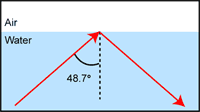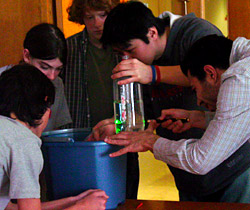Total Internal Reflection
When light hits an interface between two different media, it can behave in two different ways. Typically, the light partially refracts (bends) and partially reflects. There is a special phenomenon that occurs when light goes from a higher refractive index medium to a lower refractive index medium and above a certain incident angle. The refractive index of the material is what determines how fast light travels in a material.
We can take the interface between water and air as an example. Water has a higher refractive index than air. When light is propagating from water to air, for all angles less than a certain critical angle, the light gets transmitted through. But once the angle is larger than the critical angle; all of the light gets reflected. This is what is called total internal reflection. This is explained by what is known as Snellís law, which shows the relationship between the incidence angle and the refractive index of the material. The equation for Snellís law is ni sin ϴi = nt sin ϴt, where n is the refractive index of the material and ϴi is incident angle, and ϴt is transmitted angle. So for the critical angle where there is no transmission, ϴt = 90° and Snellís law can be rewritten such that
In this case, nt is the refractive index of air and ni is the refractive index of water. The refractive index of air is 1.0 and the refractive index of water is 1.33 so the critical angle for total internal reflection for a water-air interface is 48.7°.

Required Materials
Laser pointer (preferably green)
Empty 2-liter soda bottle (clear)
Rubber plug
Bucket
Water
Activity Directions
- Make a circular hole close to the bottom of the empty soda bottle. Plug the hole with the rubber plug and fill with water.
- Situate the soda bottle above the bucket.
- Aim the laser pointer through the soda bottle to the hole. As a safety precaution, do not point the laser at anyone!!
- Remove the plug and allow the water to pour into the bucket.

You should be able to see some of the reflections of the green light through the water as it flows down. The light is being guided through the water, which has a higher refractive index than air. You can also experiment with different materials such as glass.
One application that makes use of total internal reflection is optical fiber. Typical optical fiber is made from glass and there is a core and a cladding. The core is where the light is guided and has a slightly higher refractive index than the cladding. Optical fibers are used for many applications such as telecommunication, sensors, imaging, and illumination.

Want to Learn More? Read an article related to this activity:









